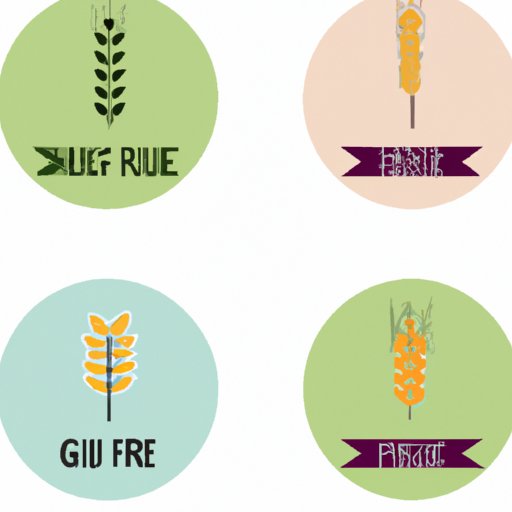
Introduction
Gluten-free diets have become increasingly popular in recent years. You may have heard of gluten-free options at restaurants or seen “gluten-free” labels at the grocery store. But what is gluten, and why is it important to understand what makes something gluten-free? In this article, we’ll explore the ins and outs of gluten-free diets, including labeling, alternatives, benefits, and myths, so you can make informed choices about your health.
Gluten-free labeling
First things first: what exactly is gluten? Gluten is a protein found in grains like wheat, barley, and rye. For people with celiac disease or gluten sensitivity, consuming gluten can cause a range of symptoms, from digestive issues to skin problems to headaches. That’s why it’s so important to have clear labeling on food products.
In the United States, the Food and Drug Administration (FDA) has specific regulations for what can be labeled as “gluten-free.” According to the FDA, any food or beverage with less than 20 parts per million (ppm) of gluten can be labeled gluten-free. This standard helps ensure that people with celiac disease or gluten sensitivity can safely consume products labeled as gluten-free without worrying about cross-contamination or hidden gluten.
When you’re shopping for gluten-free products, it’s important to read the label carefully. Some products may be naturally gluten-free, while others may have undergone processing to remove gluten. Additionally, some products may be labeled “wheat-free” but still contain gluten from other grains like barley or rye.
Gluten-free alternatives
If you’re looking to eliminate gluten from your diet, there are a variety of alternatives available. Some popular gluten-free flours and grains include:
- Almond flour
- Buckwheat
- Coconut flour
- Cornmeal and corn flour
- Oat flour (look for certified gluten-free oats)
- Quinoa
- Rice flour
These flours and grains can be used to make everything from bread and pasta to cakes and cookies. However, it’s important to note that gluten-free flours may not behave the same way as wheat flour in recipes. Some trial and error may be necessary to achieve the desired texture and flavor.
If you’re new to cooking with gluten-free alternatives, there are a few tips to keep in mind. First, start with simple recipes that don’t require a lot of substitutions or adjustments. Second, use a gluten-free all-purpose flour blend that already contains a mix of different flours and starches, which can make the transition easier. Third, be patient and don’t give up if your first few attempts aren’t perfect. With practice, you’ll get the hang of it.
Gluten-free benefits
There are several potential health benefits to a gluten-free diet. For people with celiac disease, eliminating gluten is the only way to prevent damage to their small intestine and improve their long-term health. For people with non-celiac gluten sensitivity, going gluten-free may alleviate symptoms like bloating, fatigue, and brain fog.
Beyond these specific conditions, some people choose to go gluten-free for a variety of reasons. For example, some research suggests that a gluten-free diet may help improve symptoms of autism, although more studies are needed to confirm this. Additionally, some people report feeling less bloated or having more energy on a gluten-free diet.
However, it’s important to note that a gluten-free diet isn’t inherently healthier than a diet that includes gluten. In fact, some gluten-free products may be more processed or contain more sugar and fat than their gluten-containing counterparts. It’s important to focus on consuming a balanced diet that includes a variety of whole foods, regardless of whether or not they contain gluten.
Gluten-free myths
Despite the growing popularity of gluten-free diets, there are still several myths and misunderstandings surrounding gluten. Here are a few common ones:
- Myth: Gluten-free is always healthier.
- Fact: Some gluten-free products may be less nutritious or contain more sugar, fat, or salt than regular products. It’s important to read the label and choose whole foods whenever possible.
- Myth: Gluten causes weight gain.
- Fact: There’s no evidence to support this claim. In fact, some studies suggest that eliminating gluten without making other dietary changes may lead to weight gain.
- Myth: If you don’t have celiac disease, you don’t need to worry about gluten.
- Fact: While celiac disease is the most well-known condition related to gluten, some people may also have non-celiac gluten sensitivity. Symptoms can vary widely and may include digestive issues, headaches, joint pain, and fatigue. If you suspect gluten may be causing your symptoms, talk to your healthcare provider before making any major dietary changes.
It’s also important to note that self-diagnosing a gluten sensitivity can be dangerous. Without a proper diagnosis from a healthcare provider, you may miss out on treatment for other underlying conditions and put yourself at risk for nutritional deficiencies or other health problems.
Conclusion
Understanding what makes something gluten-free is an important part of making informed choices about your health. By reading food labels carefully, experimenting with gluten-free alternatives, and debunking common myths, you can make the best decisions for your body. Whether you have celiac disease, gluten sensitivity, or are simply curious about gluten-free diets, there are plenty of resources available to help you succeed.
Future outlook for gluten-free diets: As gluten-free diets continue to gain popularity, it’s likely that we’ll see more gluten-free products and restaurants cater to this trend. However, it’s important for consumers to stay informed and not rely solely on marketing claims or popular trends to make dietary decisions.





